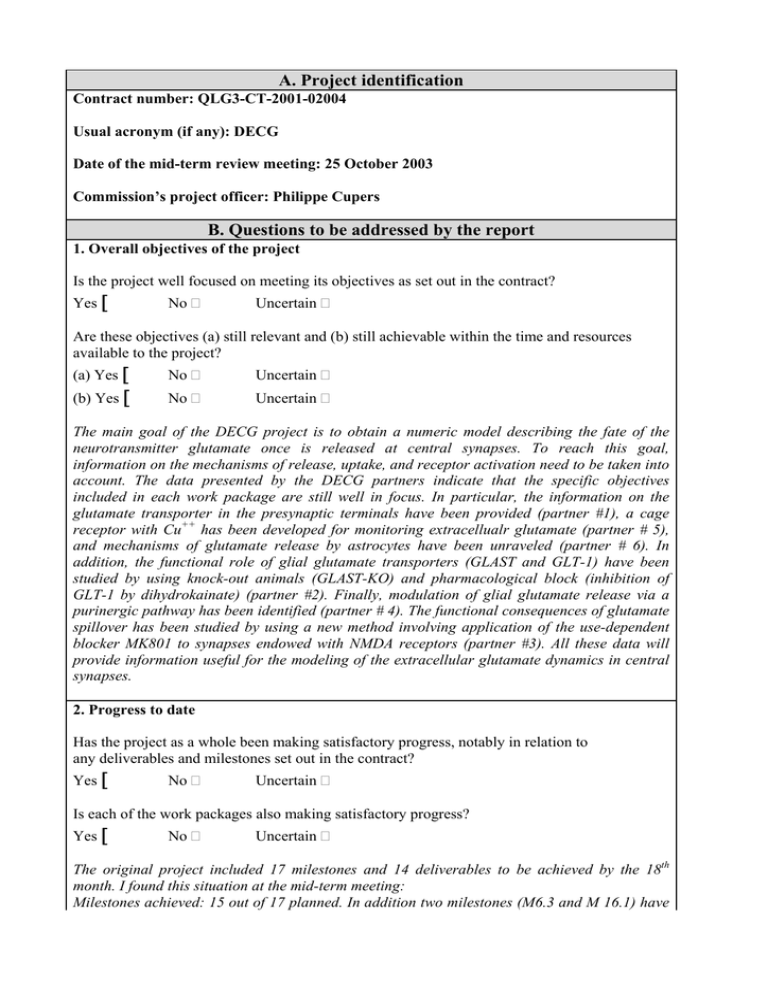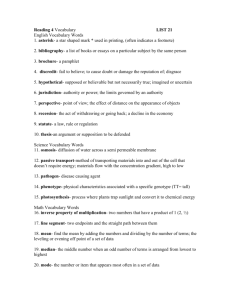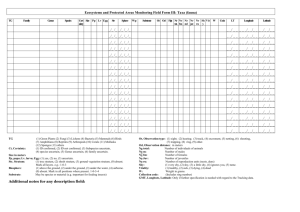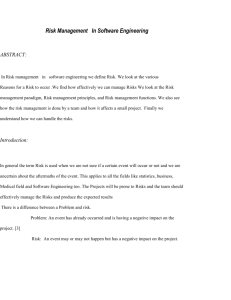A. Project identification
advertisement

A. Project identification Contract number: QLG3-CT-2001-02004 Usual acronym (if any): DECG Date of the mid-term review meeting: 25 October 2003 Commission’s project officer: Philippe Cupers B. Questions to be addressed by the report 1. Overall objectives of the project Is the project well focused on meeting its objectives as set out in the contract? Yes [ No Uncertain Are these objectives (a) still relevant and (b) still achievable within the time and resources available to the project? (a) Yes [ (b) Yes [ No Uncertain No Uncertain The main goal of the DECG project is to obtain a numeric model describing the fate of the neurotransmitter glutamate once is released at central synapses. To reach this goal, information on the mechanisms of release, uptake, and receptor activation need to be taken into account. The data presented by the DECG partners indicate that the specific objectives included in each work package are still well in focus. In particular, the information on the glutamate transporter in the presynaptic terminals have been provided (partner #1), a cage receptor with Cu++ has been developed for monitoring extracellualr glutamate (partner # 5), and mechanisms of glutamate release by astrocytes have been unraveled (partner # 6). In addition, the functional role of glial glutamate transporters (GLAST and GLT-1) have been studied by using knock-out animals (GLAST-KO) and pharmacological block (inhibition of GLT-1 by dihydrokainate) (partner #2). Finally, modulation of glial glutamate release via a purinergic pathway has been identified (partner # 4). The functional consequences of glutamate spillover has been studied by using a new method involving application of the use-dependent blocker MK801 to synapses endowed with NMDA receptors (partner #3). All these data will provide information useful for the modeling of the extracellular glutamate dynamics in central synapses. 2. Progress to date Has the project as a whole been making satisfactory progress, notably in relation to any deliverables and milestones set out in the contract? Yes [ No Uncertain Is each of the work packages also making satisfactory progress? Yes [ No Uncertain The original project included 17 milestones and 14 deliverables to be achieved by the 18th month. I found this situation at the mid-term meeting: Milestones achieved: 15 out of 17 planned. In addition two milestones (M6.3 and M 16.1) have been achieved in advance. Milestones M14.1 and M14.2 are in progress. Deliverables achieved: 13 out of 14 planned. One is in progress (D5.3), and 7 has been achieved in advance (D3.3, D4.2, D7.2, D9.2, D9.3, D9.4, D16.1). These results support my view that the project as well as each work packages are making very satisfactory progress. 3. Research approach Is the project following the research approach set out in the contract? Yes [ No Uncertain Is this approach still appropriate to achieve the project’s objectives? Yes [ No Uncertain The research approach set out in the contract is followed as planned. The methodological approaches (e.g., TIRM, immunocytochemistry, electrophysiology) are still appropriate. 4. Contribution of the partners Are all the partners making their foreseen contribution to the project? Yes [ No Uncertain Is there evidence of meaningful co-operation between all the partners? Yes [ No Uncertain All the partners are making the planned contributions. Co-operation is strong in the DECG group, as documented by joint publications. 5. Project management Is the project well managed and well co-ordinated, from the scientific, organisational and Financial point of views? Yes [ No Uncertain Does the project co-ordinator have the necessary resources to carry out his/her work effectively? Yes [ No Uncertain Is full advantage being taken of up-to-date communication systems? Yes [ No Uncertain The coordinator is making an excellent job. The meeting has been well-organized and wellstructured, making it easy for me to assess the achievements and the progress of the DECG project. The coordinator seems to have all the resources to carry out his work. 6. Exploitation and dissemination Does the project have clear and appropriate strategies for exploitation and dissemination? Yes [ No Uncertain Are these strategies being effectively implemented? Yes [ No Uncertain Where relevant, are potential users and other stakeholders in the research being suitably involved in the project? Yes No Uncertain Not relevant [ Strategies for exploitation and dissemination (as set out in the original project) are appropriate. In particular, some data have been already published in international, highimpact, peer-reviewed journals. 7. Ethical aspects Is the project fulfilling its contractual commitments concerning ethics, if any? Yes [ No Uncertain Not relevant Are there potential causes for concern? Yes No [ Uncertain Not relevant All ethical aspects related to animal experimentation seem to be fulfilled. 8. Safety provisions Is the project fulfilling its contractual commitments concerning safety, if any? Yes [ No Uncertain Not relevant Are there potential causes for concern? Yes No [ Uncertain Not relevant There are no apparently inherent risks in this project at this stage. C. Overall assessment and recommendations. 9. Do you consider that the project will contribute usefully to the objectives of the QoL Programme? Yes [ No Uncertain I think that this project is pivotal to develop therapeutic intervention aimed at preventing the glutamate excitotoxicity in pathological processes. 10. Would you recommend that the project should continue unchanged? Yes [ No Given the fact that the project is well-focused and that the partners are carefully conducting the research as planned, I would recommend that the project should continue as it was designed. 11. Please mention any further recommendation, remark or comment that you might wish to make: The mid-term review meeting has been well-organized by the project coordinator. The talks given by all the project partners have been very informative and detailed, and have stimulated an interesting discussion among the meeting attendees. All the questions I raised have been adequately answered. I found a strong collaborative partnership in this DECG project, as indicated by the sharing of scientific knowledge, technological know-how, personnel, and as documented by joint publications. I was impressed by the outstanding level of the technical capabilities displayed by all participants. In addition, the scientific output in terms of publications was excellent. Findings have been published in leading, peer-reviewed journals, such as Proceedings of National Academy of Sciences USA, Journal of Neuroscience, Journal of Neurophysiology, Journal of Physiology, European Journal of Neuroscience. In all the publications I saw, EU support has been acknowledged. In conclusion, I had a very positive impression of the DECG group from the mid-tem meeting. Name of the reviewer: Albertino BIGIANI Date: October 31st, 2003 Signature:







